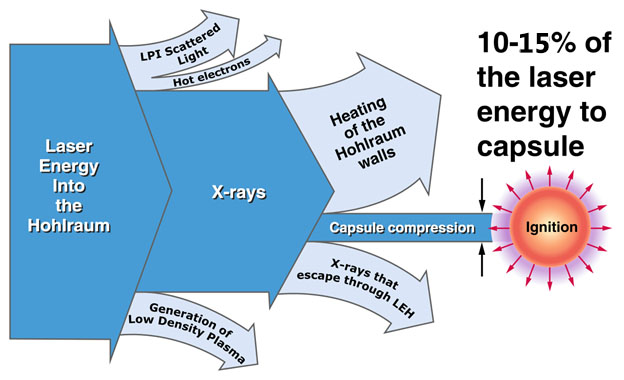A fusion reaction at the National Ignition Facility produced a record 1.3 MJ of fusion energy, releasing more energy than the fuel capsule absorbed for the first time.
Nuclear fusion reactors, if fully realised, have the potential to provide the world with an almost infinite supply of clean energy. Unfortunately, that potential is still a long way from being realised. However, Debbie Callahan of Lawrence Livermore National Laboratory (LLNL), California, announced at the recent Annual Meeting of the APS Division of Plasma Physics that researchers had, for the first time, triggered “ignition”—a fusion reaction that produces more energy than it receives and can thus burn on its own.

The LLNL’s National Ignition Facility (NIF) experiment brings commercial fusion-energy reactors one step closer to reality. It also serves as a platform for learning about materials under harsh conditions. A paper will be submitted for peer review by the LLNL scientists.
Inertial confinement fusion is generated by compressing a millimetre-sized capsule containing a thermonuclear fuel combination of deuterium and tritium. The capsule is heated by x rays produced by high-power lasers, converting it to plasma. This plasma speeds inward like a collapsing star, compressing the capsule’s deuterium-tritium fuel into a small sphere with a temperature greater than 100 million degrees Celsius and a pressure greater than 100 billion times that of Earth’s atmosphere. Hydrogen atoms in the fuel fuse under these conditions release energy.
These fusion processes must be self-sustaining to heat the plasma sufficiently to induce more fusion events in a commercial fusion reactor. According to Imperial College London plasma physicist Jeremy Chittenden, this self-sustaining situation is fundamentally what is meant by ignition. However, “it’s quite difficult to determine directly what’s going on inside the fuel,” he explains.
No plant had reached this ignition threshold before August of this year. On August 8th, an updated experiment yielded 1.3 MJ, approximately eight times more energy than NIF’s previous record. Because it produced less than the 1.9 MJ delivered by the facility’s 192 laser beams, early reports referred to this achievement as the “brink of ignition.” However, many fusion experts believe that such a stance is unduly conservative.
“As far as most people working in the field are concerned, the scientific demonstration of the ignition process has indeed been achieved,” Chittenden says.

The question now is, what caused this significant increase in output? The most recent experiment tested various equipment, fuel, and techniques advancements. According to the researchers, it is the product of meticulous work, including the design of the capsule, better laser precision, new diagnostic instruments, and design tweaks to accelerate the pace of the capsule’s implosion, which transfers more energy to the plasma hotspot where fusion occurs.
“Gaining experimental access to thermonuclear burn in the laboratory is the culmination of decades of scientific and technological work stretching across nearly 50 years,” said Thomas Mason, director of the Los Alamos National Laboratory.
“This enables experiments that will check theory and simulation in the high energy density regime more rigorously than ever possible before and will enable fundamental achievements in applied science and engineering.”
So, are commercial fusion reactors on the horizon? Not according to Callahan, who describes this development as an “important step down a long road.” To create a commercially feasible fusion reactor, the reaction must yield much more energy than the reactor requires to operate.
The 1.9-MJ laser input requires around 400 MJ of electricity. And a large portion of the laser energy is lost before it reaches the hydrogen fuel. Significant loss can occur in a metal cylinder called a hohlraum surrounding the capsule. The hohlraum converts the laser light into x rays, which carry laser energy to the fuel. However, a significant portion of the input energy is wasted due to the heating of the hohlraum walls. NIF’s short-term goal is to reduce the fraction of energy wasted in the hohlraum.

Nuclear fusion researchers are also looking into new research routes that have opened up due to the achievement of a new experimental environment.
“It’s an extremely exciting time to be working on this topic,” Callahan says. “Our field is really in a place that we’ve never been before.”


